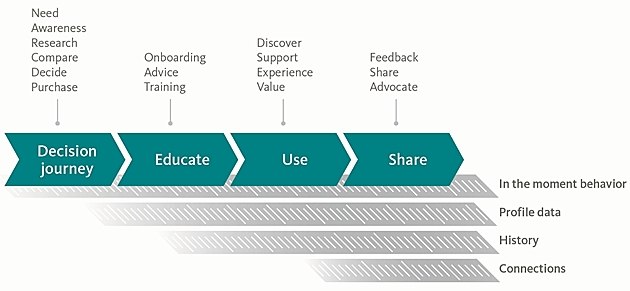"One machine can do the work of 50 ordinary men," Elbert Hubbard said. A similar analogy can be made about experience marketing: You are, in effect, building a customer-centric marketing machine that will multiply the results of your efforts.
But what ingredients will enable you to make a measurable contribution to sales while optimizing your marketing spend?
As digital has evolved across many channels, most organizations have introduced different technologies for email, social, websites, analytics, and so on. A scattered technology landscape means siloed data at each point of interaction, creating a disconnected customer experience. Unless the points of interaction and data become integrated, we "forget" all data about our customers from past interactions.
For example, when I bought the iPhone 6 Plus, I used my iPhone 5 to visit Apple.com. After 20 minutes of zooming and shrinking—the website wasn't optimized for mobile—I managed to order it. When I went back to the homepage, I saw a promotion to buy an iPhone 6 Plus. When I received my order email, I clicked to find more promotions for the iPhone 6 Plus. Five days later, I received yet another email promoting the new iPhone 6 and 6 Plus.
That experience could have been made much more relevant if Apple had sent me emails about getting the most out of the new iPhone and suggested certain accessories to consider. Instead, it was a disconnected experience and a missed opportunity for Apple to build a better relationship and sell me more merchandise.
As consumers, we find such experiences frustrating. We don't want to be marketed or sold to; we want relevant information from companies we trust. However, most of us have disconnected experiences when we interact with a brand.
So, what can we do as marketers to create more connected experiences for our customers?
We need to go from inside-out digital marketing to outside-in, cross-channel experience marketing, which focuses on the customer's needs and intent. (For more on this topic, check out the Marketing Smarts podcast with Lars Petersen.)
The following four actions are key for experience marketing.
1. Align objectives and use (better) metrics that executives can understand
The first step in experience marketing is to establish a cross-channel metric that executives can trust. We call this metric "engagement value."
Engagement value aligns key interactions with the most important business objectives. For instance, a call conversion gets a value of 100, and signing up for newsletter gets a value of 20.
Once established, engagement value allows the organization to compare channels and see the effect of each marketing campaign in terms of a consistent metric: In email marketing, for example, in terms of value instead of just clickthroughs.
2. Understand your customers and their intent across the entire life cycle
To build meaningful experiences for our customers, we must understand their intent and motivations.
A quick way to start is to map your three key customer segments—place them on the left side of a page—with the different stages of the decision journey (or even the full life cycle) at the top of the page; for each stage a customer segment is in, describe its intent, touchpoints, and objectives; then map that to what content would be most relevant and which interactions you would like them to complete.
Doing so will reveal content gaps and also some more low-commitment interactions vs. the hard-sell "Call me now."
3. Collect and connect data into a single view of the customer, starting from the first anonymous interaction
Create a connected customer profile by enabling a single view of the customer, designed to scale. That profile would include a variety of data, such as contact information, channel and device preferences, persona match, profile behavior, campaign history, responses, transactions, and so on.
Your goal is a connected single view of the customer built from data collected from all online and offline repositories. Start by connecting a couple of key digital channels, such as website and email; together, that data is amazingly powerful.
4. Use customer data in real time to create relevant experiences
Use data in real time to personalize experiences that are connected to the single view of the customer. Beyond understanding the customer's intent and objectives, think about categorizing data according to the following:
- In-the moment-behavior: implicit interactions on your site, referral data, and geo-location
- Profile data: explicit data like gender, age, address, and other information entered into Web forms and through social connect/login
- History: past transactions and interactions
- Connections: people to whom the customer is connected
Access to data evolves over time as you build trust with customers and they are willing to share more data.
Regardless, you can always bet on the category of "in-the-moment behavior." For a first-time visitor, use referral data and site behavior to personalize the main content spots, focusing on unlocking the email channel by getting an email opt-in. For known visitors, trigger relevant email based on their site interactions.

As you build your customer-centric marketing machine, make sure you're thinking cross-channel. The more connected, the better the experience becomes.
Image included with permission of the publisher, Wiley, from Connect: How to Use Data and Experience Marketing to Create Lifetime Customers by Lars Birkholm Petersen, Ron Person, Christopher Nash.




